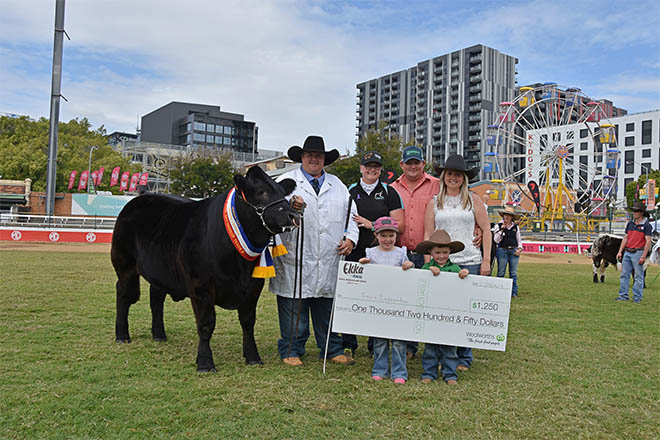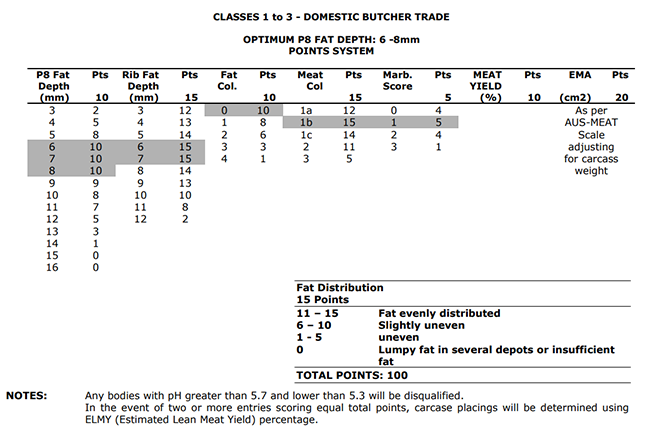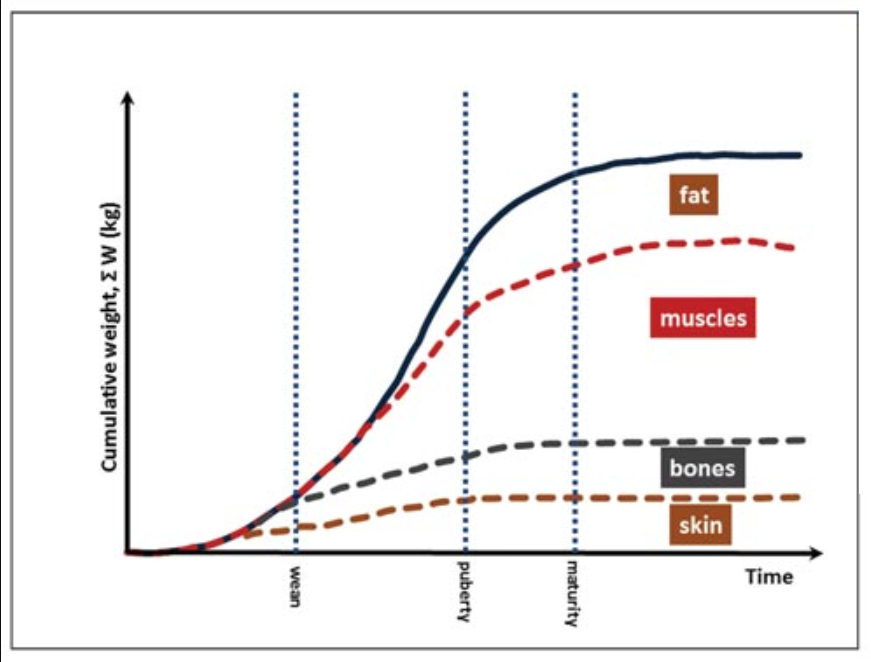The 2022 led steer show season is in full swing and many of you may be considering a feeding program for your show team.
Targeted nutritional planning is key to maximising the genetic potential of your cattle, and giving them every possible chance to take home the broad Grand Champion ribbon.
Selection of a finished feed to prepare show cattle is dependent on many factors. Some guidelines for selecting and feeding products include:
Formulation
- Your steer’s diet must be nutritionally balanced to ensure protein and energy requirements are met and nutrient deficiencies are avoided
- Palatability is important- show cattle are often on and off feed for months or years in some cases and must be provided with palatable feeds and roughages
- Do your research – read product specifications to assess the quality of raw materials. Not all commercial feeds are created equally and sometimes, poorer quality ingredients may hinder the success of your show team.
- Diet composition - if aiming for specific fat colour, marbling and meat colour there are nutritional considerations which may influence these characteristics, although genetics play a large role in the expression of some of these traits.
Induction
- Correct induction timing will ensure proper rumen adaptation and prevent the occurrence of acidosis. Ad-lib roughage must be available at all times.
- Health status - vaccination and drenching must be up to date and cattle must be physically and structurally sound.
- Cattle must be introduced to new grain based rations over a 3-4 week period, while increasing the amount of grain from <0.5kg/head/day up to the desired rate every 4-5 days in stages. For example - Day 1 =0.5kg, Day 4= 0.75kg, Day 8= 1kg, Day 12= 1.25kg and so on.
- If using a self-feeder, begin with the slides at a pencil width to ensure cattle have to ‘lick’ the pellets or meal out. Make sure the tray and opening is cleaned daily. The slides can then be lifted every 4-5 days to the desired level.
Feeding Systems
Self-feeders
Pellets are often ideal in this situation due to flowability, however meals may also be used. Feeding in self feeders reduces the risk of wastage and spoilage. It is important to ensure that all cattle have adequate feeder space.Hand feeding
Both pellets and meals are suitable. There is the ability to strictly monitor intakes, but we recommend feeding 2-3 times per day consistently.Home mix into a bunk or trough
Grains must be processed e.g. hammered/rolled/steam flaked and the ration must be balanced correctly. It is important to ensure you are able to source raw materials throughout the whole year. It is recommended to feed out the ration at least 2 times per day consistently.
Social & Environmental Factors
- Weight Classes - prior to starting cattle on feed, it is beneficial to split cattle into manageable weight groups to help prevent bullying, especially if they are fed in confinement.
- Shy feeders should be identified quickly and removed from the pen to be fed elsewhere otherwise they will not perform to their potential due to reduced feed intakes, and therefore poorer performance.
- Show cattle lose body weight each time they are transported to and from a show. This must be considered when calculating weight gain expectations.
- Stress and dehydration are common during times of restricted feed intakes. This must be considered if attending a number of events and if travelling long distances. Stress management is extremely important as any stressful events will stall weight gain.
Roughage
Ad-lib roughage should be available at all times, especially when feeding grain based supplements. This can include a combination of pasture, hay, straw and silage. Feeding good quality, palatable roughage provides digestible nutrients including protein, energy, minerals and vitamins. Roughage quality is also correlated with feed intake and animal performance. Roughage should be free from mould, weeds and contamination, and kept dry and fresh to avoid any implications.
As a rule of thumb, it is recommended that show cattle are provided forage with a particle length as wide as their mouth. Longer forage particles help to promote cud chewing and rumination, stabilising rumen pH which assists in prevention of ruminal acidosis. Long forage particles also stimulate ruminal contractions, which assist with digestion, metabolism and maintenance of healthy rumen pH (NRC, 2016). Feeding of lucerne and legume hays should be discussed with your nutritionist prior to feeding due to the risk of bloat.
Water
Access to clean, cool, fresh water at all times is extremely important. Water is an essential nutrient that is often overlooked. It is required for many functions including digestion, metabolism, growth, regulation of body temperature (NRC, 2016). Water intake is a driver of feed consumption, and is positively correlated with average daily weight gain (Brew et al. 2011). Basal intakes of a 450kg steer are approximately 55L when temperatures reach 26.6°C, this increases to 78L at 32.2°C. However, many factors influence this including temperature-humidity index, stress and feed composition (NRC, 2016).
When travelling to shows, cattle must be offered water frequently, especially in hot, humid conditions. At events, the water source and hardness may limit intakes due to the unfamiliarity of the taste or aroma. Addition of molasses, specific water treatment products or soluble electrolyte transit blocks can be useful in stimulating intake.
Led Steers
Before commencing a led steer feeding program it is imperative to consider the development traits of the animal based on breed so their specific nutritional requirements can be met (e.g. British breeds mature at different rates compared to European breeds). A realistic expectation of growth, development, and weight gain is the first step in designing a feed program. It is important to research competition carcass scoring systems to set goals for the animal. Keeping in mind, the animal’s genetics play a huge part in determining all factors, particularly eye muscle area (EMA), marble score, yield, and fat distribution (Wolcott et al. 2009). Adequate nutrition assists the animal to reach their genetic potential.
As shown in Table 1, many carcass traits are assessed and scored during carcass competitions, and are weighted depending on market suitability.
Cattle with a live weight of 325-400kg fit into the category above. Earlier maturing animals would be more suitable for this class as they will be physiologically ‘ready’ for slaughter earlier than a late maturing animal. Earlier maturing animals will achieve ideal subcutaneous fat levels compared to late maturing animals, who at the same weight would typically yield a greater proportion of bone and muscle.
Fat cover is largely impacted by the animals’ stage of maturity, in combination with nutrition and other factors. As shown in Table 2 there are many changes in total cumulative bodyweight,and proportions of skin, bone, and muscle over time. This highlights that understanding the expected maturity pattern of your steer is key in designing a feeding program. This knowledge enables realistic expectations to be set, based on the breed of your animal and the associated changes in muscle and fat proportions over time.
To keep the animals’ progress on track it is good practice to plan around and revisit the following points:
- My steer is small/medium/large framed and should weigh _____kg at slaughter
- My steers' initial weight is _____kg and therefore needs to gain _____kg before slaughter
- The carcass competition/show is _____days away
- My steer will need to have an average daily weight gain of _____kg/day
When you have determined your expectations and calculated answers to the above metrics, realistic goals can be set depending on the finished feeds, roughages, or grains you have on hand.
For example - a 400kg steer consuming approximately 2.6% of its body weight in feed daily (~10.4kg/day total as fed) including 1.5% of its’ body weight in feedlot finisher pellets (6kg/day) with 12.3MJ/kg DM Metabolisable Energy (ME) and 4.5kg of oaten hay with 9MJ/kg DM ME, will be expected to gain approximately 1.2kg/day after fulfilling its’ maintenance energy requirements.
Therefore, we need to work on average daily gains within this range, unless we increase the nutrient density of the ration by increasing the pellet feeding rate or providing a higher energy pellet for instance. Alternatively, in other cases a lower rate of weight gain may be preferred, therefore a diet with a lower nutrient density may be utilised.
As the age and body size of the animal increases, energy requirements for maintenance and growth increase, in contrast to crude protein requirements which decline with age. With this in mind, the feeding program may need to be adapted accordingly, as the steer matures or approaches time of slaughter.
To sum up, providing excellent quality nutrition is non-negotiable when feeding high performing show steers. It is important to begin planning a nutrition, health, and management program well in advance, while revisiting the 4 points listed above on a regular basis to ensure you are meeting growth targets.
As mentioned, there are many factors that influence weight gain and performance, so it is important to weigh your steer and monitor their production regularly, and adjust the nutrition program as and when necessary.
For further advice on feeding steers throughout show season and leading up to slaughter, we encourage you to contact your nominated Riverina representative or Branch.
Emma is a certified animal nutritionist for Riverina Stockfeeds, and enjoys prepping and showing led steers in her down time. She has a Bachelor’s degree in Agriculture (Animal Production) and has worked for Riverina for 11 years.
References
Brew, M., Myer, R., Hersom, M., Carter, J., Elzo, M., Hansen, G., & Riley, D. (2011). Water intake and factors affecting water intake of growing beef cattle. Livestock Science, 140(1–3), 297–300. https://doi.org/10.1016/j.livsci.2011.03.030
National Academies of Sciences, Engineering, and Medicine, Studies, D. O. E. A. L., Resources, B. O. A. A. N., & Cattle, C. O. N. R. O. B. (2016). Nutrient Requirements of Beef Cattle: Eighth Revised Edition (Animal Nutrition) (8th Revised ed.). National Academies Press.
Wolcott, M. L., Johnston, D. J., Barwick, S. A., Iker, C. L., Thompson, J. M., & Burrow, H. M. (2009). Genetics of meat quality and carcass traits and the impact of tenderstretching in two tropical beef genotypes. Animal Production Science, 49(6), 383. https://doi.org/10.1071/ea08275







 Beef
Beef
 Dairy
Dairy
 Sheep
Sheep
 Horse
Horse
 Pig
Pig
 Goat
Goat
 Poultry
Poultry
 Bird
Bird
 Dog
Dog
 Special
Special
 Feed Materials
Feed Materials